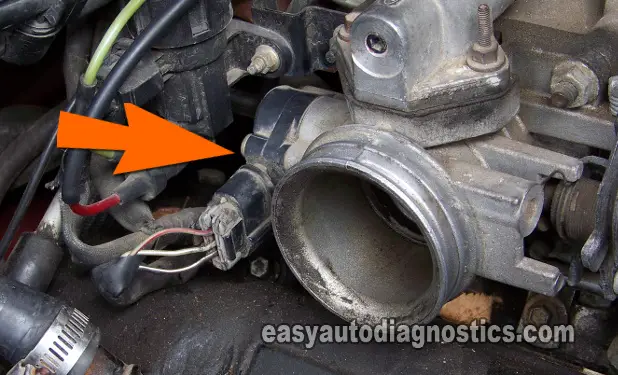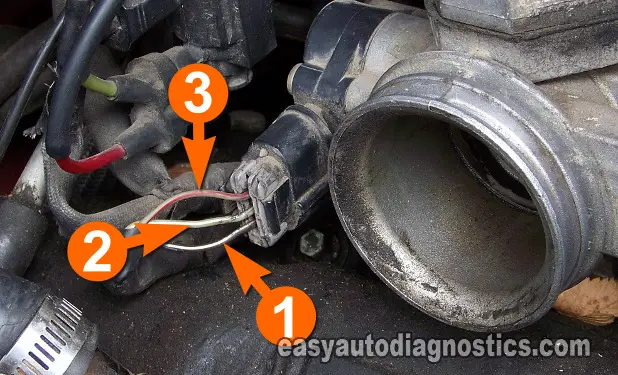
The TPS (throttle position sensor) on your 1996, 1997, and 1998 Ford Mustang, with a 3.8L V6, can be easily tested in three simple steps and using just a multimeter.
No scan tool is needed to troubleshoot and test the Mustang TPS and this article will show you how to get it done.
This section has all the info you need to be able to successfully accomplish the 3.8L Mustang TPS test, so before jumping into the tests, read this section first.
Contents of this tutorial:
- Symptoms Of A Bad Ford Mustang TPS.
- What Tools Do I Need For The TPS Test?.
- Circuit Descriptions Of The Mustang 3.8L TPS.
- How Does The Ford Mustang TPS Work?.
- Where To Buy The TPS And Save.
- TEST 1: Testing The TP Signal.
- TEST 2: Testing The 5 Volt Reference Signal.
- TEST 3: Testing The Sensor Return (Ground) Circuit.
- TPS Code Won't Go Away.
![]() You can find this tutorial in Spanish here: Cómo Probar El Sensor TPS (1996-1998 3.8L Ford Mustang) (at: autotecnico-online.com).
You can find this tutorial in Spanish here: Cómo Probar El Sensor TPS (1996-1998 3.8L Ford Mustang) (at: autotecnico-online.com).
APPLIES TO: This tutorial applies to the following vehicles:
- Ford Mustang 3.8L: 1996, 1997, 1998, 1999, 2000, 2001, 2002, 2003, 2004
NOTE: You can find the TPS test for the 1994-1995 3.8L Ford Mustang here: How To Test The TPS With A Multimeter (1994-1995 3.8L Mustang).
Symptoms Of A Bad Ford Mustang TPS
Besides a nagging check engine light (CEL) being on on the instrument cluster and driving you insane, here are some other symptoms your 3.8L Mustang may be experiencing:
- TPS diagnostic trouble codes (DTCs) stored in the vehicle's computer's memory.
- P0121: Throttle Position (TP) Circuit Performance Problem.
- P0122: Throttle Position (TP) Circuit Low Input.
- P0123: Throttle Position (TP) Circuit High Input.
- Really bad gas mileage.
- Transmission does not shift out of second gear.
- No power as you accelerate the vehicle.
- Hesitation when you step on the accelerator pedal.
What Tools Do I Need For The TPS Test?
A multimeter is going to be your best friend in testing your Mustang's throttle position sensor (TPS). It doesn't have to be fancy and expensive one (don't have a digital multimeter? Need to buy one? Click here to see my recommendations: Buying A Digital Multimeter For Automotive Diagnostic Testing). You can use a Digital multimeter or an analog multimeter.
You will need a helper to perform TEST 3 of this Mustang TPS test article.
Circuit Descriptions Of The Mustang 3.8L TPS

I'm sure you know by now that the Mustang's TPS has three wires sticking out of it. Below, you'll find out what each wire (circuit) does. All three circuits start and end at the PCM (Powertrain Control Module=Fuel Injection Computer) or vice-versa, depending on how you look at it.
- Circuit labeled 1:
- 5 Volts from PCM.
- Circuit labeled 2:
- Throttle Position (TP) Signal Circuit.
- Circuit labeled 3:
- Sensor Return (Ground) Circuit.
One very important testing tip I'm going to share with you that may save you a big headache is that you should not probe the front of the TP sensor connector's terminals to test for the 5 Volts and Ground signals. It's best to use a tool to pierce the wire, such as a wire-piercing probe (click here so that you can see what one looks like: Wire Piercing Probe) to get to and verify the presence of the signals.
Another important tip since these three circuits go directly to the PCM, you need to be careful not to short these wires to power (12 Volts) or you'll fry the PCM.
How Does The Ford Mustang TPS Work?
Here, in a nutshell is how the TPS on your Ford Mustang (with the 3.8L V6) works when you crank and start it:
- The PCM supplies the TP sensor with 5 Volts and Ground.
- Once the engines starts and is running (idle), the TPS measures the angle of the throttle plate (at its closed position since the engine is just idling) and sends this base measurement of about 0.9 to 1 Volt to the PCM.
- Once you throw the car in drive and accelerate the car to get it moving, the throttle position sensor measures the amount of throttle plate opening (caused by your foot action on the accelerator pedal) into a rising DC voltage signal the PCM uses to do its little song and dance and calculate fuel injection, ignition timing, transmission shift points, and everything else it needs to make the Mustang run efficiently.
- As you let go off the accelerator pedal to slow down, the throttle plate closes and of course the TP sensor sends the info to the PCM as it returns to its base voltage signal, till the whole cycle begins again.
Nothing complicated, right? The cool thing is that the tests to check out the TP sensor's performance are as easy too. Now, since you'll be working in the engine compartment take all necessary safety precautions and use common sense. OK, enough of my yakking, let's get this show on the road, go to: TEST 1: Testing The TP Signal.
Where To Buy The TPS And Save
The best place to buy the TPS is online. The following links will help you to comparison shop for the throttle position sensor:
Disclosure: As an Amazon Associate, I earn from qualifying purchases. Buying through these links helps support this site at no extra cost to you. Thanks for your support —it really means a lot!
Not sure if the above TP sensor fits your particular 3.8L Ford Mustang? Don't worry, once you get to the site, they'll make sure it fits by asking you the particulars of your vehicle. If it doesn't fit, they'll find you the right one.
TEST 1: Testing The TP Signal

If the throttle position sensor (TPS) is working correctly, when you open the throttle plate, the multimeter will register a smooth increase in the DC voltage until the maximum voltage is reached, which is about 4.5 Volts DC.
As you slowly release the throttle plate back to its closed position, the multimeter will display a gradual decrease in voltage till the initial base voltage is achieved (which you recorded in the beginning of the test).
If the TPS is bad, then there will be sudden gaps/loss of voltage as you increase or decrease the throttle plate's to its fully open or fully closed position, especially when you tap on the sensor. Or, there will be no voltage reading at all. OK then, here are the two possible outcomes:
You'll need a helper to assist you in this test step, since he or she will need to lightly tap on the throttle position sensor's body with a screw driver (or other appropriate tool) while you observe the multimeter and manually actuate the throttle.
OK, let's start testing:
PART 1
- 1
Select Volts DC mode on your multimeter.
- 2
Probe the circuit labeled with the number 2 in the photo with the red multimeter test lead, using an appropriate tool to pierce the wire.
- 3
Ground the black multimeter test lead directly on the battery negative (-) terminal.
- 4
Turn the Key On with the engine Off.
Your multimeter should register about 0.9 to 1 Volt (this voltage specification might vary a little bit on your vehicle).
PART 2
- 5
Manually rotate the throttle plate by hand as you eye-ball the multimeter's voltage readings.
- 6
The multimeter's initial voltage reading should increase smoothly as you open the throttle plate to its Wide Open Position. At Wide Open Throttle, the reading on your multimeter should read about 4.5 to 4.9 Volts DC.
- 7
Now, slowly release the throttle plate to its fully closed position, all the while observing the multimeter's reading.
- 8
The multimeter's voltage reading should decrease in a smooth and linear fashion back to the exact same voltage you noticed in step 5.
PART 3
- 9
OK, now have your helper lightly tap the TP sensor with the butt of a screw-driver's handle (or something similar).
- 10
As your helper taps, slowly and smoothly open the throttle to its open-wide position. The readings on your multimeter should increase and max out at about 4.5 to 4.9 Volts DC, at Wide Open Throttle.
- 11
Now, slowly release the throttle back to its closed position. Your multimeter should read the base voltage that you recorded in step 5 of this test.
- 12
All the while you've got your eyes glued on the multimeter to see if the tapping affects the voltage readings.
- 13
Repeat this (tapping the throttle position sensor) several times to make sure of your results.
Let's interpret your test result:
CASE 1: The multimeter registered a smooth increase or decrease in voltage. This is the correct test result.
You can conclude that the TP sensor is working OK and is not the cause of the TPS fault code issue. Go to: TPS Code Won't Go Away for a few more suggestions as to what could be causing the TPS diagnostic trouble code (DTC).
CASE 2: The multimeter DID NOT register an increase or decrease in voltage as you opened/closed the throttle plate. The next step is to make sure that the TPS is getting 5 Volts. For this test go to: TEST 2: Testing The 5 Volt Reference Signal.


